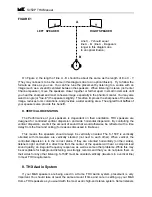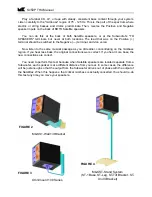
If you want to experiment further, you can move the Satellite speakers either towards or away
from your listening position, making changes in small increments. This will "focus" the system's
sound to its optimum. When you hear the best balance between stereo image localization and
maximum impact and output in the mid-bass, you have the ideal location.
10. Speaker Mounting Options
The S-150P has many stand and wall mounting options that make proper placement and
installation easy and straightforward. M&K ST series (wall brackets and stands - see FIGURE 2
& 4), are recommended because they are designed to facilitate proper installation. The
omnimount 100 Series wall brackets (Figure 3) can also be used. Included with this manual are
artist renderings detailing multiple bracket and stand mounting options. For more specific
installation instructions please consult the manuals included with the stand and bracket
hardware.
11. Speaker Damage and How To Avoid It
An important factor to consider with any loudspeaker system is the potential for speaker
damage.
Even though your M&K Speakers have extremely high power handling ability
(especially for Main speakers), they still can be damaged by relatively low powered amplifiers.
While very few M&K Speakers are actually returned for service, the vast majority of those
returned are not for manufacturing defects. Instead, they are returned because they have been
overdriven, almost always because the amplifier or receiver used was driven into clipping
distortion. This damage is considered abuse, and is not necessarily covered under warranty.
This clipping distortion occurs when the demands of the music are greater than the
amplifier's available power. It can occur at 20 watts with a small amplifier, or at 400 watts with a
large amplifier. When this happens, the amplifier's output waveform (which should look like a
smooth arc) is "clipped" off, exhibiting a flat top instead of the arc.
This "clipped" waveform contains multiples of the original amplified frequencies, sometimes
at higher levels than the original signal itself. For tweeters, this can be very damaging, as this
distortion is well above the audible range (where you are unable to hear it), and where the
tweeter is most vulnerable to damage.
When an amplifier "clips", it generates a high level of high frequency energy (much higher
than normal program material) which passes through the crossover to the tweeter. This energy
can overheat the tweeter in a matter of seconds and destroy it. When this happens, the sound
becomes harsh and grating, and a break-up is often audible in the bass frequencies. It will
become uncomfortable to listen to, especially when compared to a slightly lower volume level.
When you are listening at high volume levels, be aware of the onset of clipping distortion, and
turn the volume down slightly if the sound takes on the character described above.
When tone controls or equalizers are used to boost frequencies, the problem occurs much
more rapidly.
Even a small boost of low or high frequencies can easily double the power
requirement and lead to amplifier clipping at moderate levels. Therefore, you should use your
tone controls judiciously, avoiding extreme boosts of the bass and treble controls, especially
when you are listening at high volume levels.
S-
150P THX Manual
Содержание S-150P THX
Страница 13: ...FIGURE 5 S 150P THX Manual...
Страница 16: ...S 150P THXmanual...


































